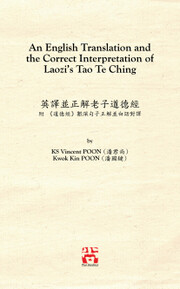Tao Te Ching
道德經
Background information
Tao Te Ching (《道德經》, or Dao De Jing), presumably written by Laozi (老子) of the 6th century BC, is one of the most famous and influential philosophical works in Chinese history. Written in fewer than 6000 Chinese characters, Tao Te Ching outlines the characteristics and roles of the fundamental Tao (道) and its Te (德, Manifestation of Tao) in the formation and maintenance of all in the Universe. Remarkably, it also depicts the underlying nature of governance and some natural laws, which, surprisingly, include modern scientific concepts such as atomic theory, chemical equilibrium, polarities, and the quantum uncertainty principle.
Unfortunately, Tao Te Ching is often misinterpreted by many for more than two thousand years. Their failures are mainly attributed to applying Taoist Religion (道教), Huang-Lao (黄老), and Confucian concepts in interpreting characters such as “鬼”, “神”, “仁”, “慈”, “善”, and “德”. Further, “若”, “似”, and “或” are also frequently misinterpreted, giving rise to the incorrect impression that Laozi was a scheming and calculating philosopher. Prominent interpreters of the past and present, including Heshang Gong (河上公), Wang Bi (王弼), Gao Heng (高亨), and James Legge, have all committed these types of errors in varying degrees.
This book provides readers with an annotated, line-by-line, concise, consistent, and correct English translation and interpretation of Tao Te Ching. Accompanied 674 footnotes include references and brief discussions on general misunderstandings. Further, to facilitate easy reading, the bare translated text is supplemented in a separate section, while the correct interpretation of difficult and complex sentences in vernacular Chinese (《道德經》艱深句子正解並白話對譯) in another. Accordingly, this book is perfect for anyone interested in Chinese philosophy.
Original Chinese Text
(Wang Bi's 王弼 Edition)
English Interpretation
by KS Vincent Poon (潘君尚) and Kwok Kin Poon (潘國鍵)
第三十四章 Chapter 34
____
100. 大道氾兮, 其可左右。萬物恃之而生而不辭; 功成不名有; 衣養萬物而不為主。
The great Tao flows and permeates everywhere (氾) indeed (兮); it influences all (左右). All things rely on (恃) it to spawn and flourish, yet it does not proclaim (辭) itself to be so. It claims (名) no credit (有) in its accomplishments. Tao embraces (衣) and nurtures the physical beings of all but never claims to be their master (主).
101. 常無欲可名於小; 萬物歸焉而不為主, 可名為大。以其終不自為大, 故能成其大。
第三十五章 Chapter 35
102. 執大象,天下往。往而不害,安平大。樂與餌,過客止。
103. 道之出口,淡乎其無味,視之不足見,聽之不足聞,用之不足既。
第三十六章 Chapter 36
104. 將欲歙之,必固張之;將欲弱之,必固強之;將欲廢之,必固興之;將欲奪之,必固與之。
105. 是謂微明。柔弱勝剛強。魚不可脫於淵,國之利器不可以示人。
第三十七章 Chapter 37
106. 道常無為而無不為。侯王若能守之,萬物將自化。化而欲作,吾將鎮之以無名之樸。
107. 無名之樸,夫亦將無欲。不欲以靜,天下將自定。
第三十八章 Chapter 38
108. 上德不德,是以有德;下德不失德,是以無德。上德無為而無以為;下德為之而有以為。
109. 上仁為之而無以為;上義為之而有以為。上禮為之而莫之應,則攘臂而扔之。
110. 故失道而後德,失德而後仁,失仁而後義,失義而後禮。
111. 夫禮者,忠信之薄,而亂之首。前識者,道之華,而愚之始。是以大丈夫處其厚,不居其薄;處其實,不居其華。故去彼取此。
第三十九章 Chapter 39
112. 昔之得一者:天得一以清;地得一以寧;神得一以靈;谷得一以盈;萬物得一以生;侯王得一以為天下貞。
113. 其致之,天無以清,將恐裂;地無以寧,將恐發;神無以靈,將恐歇;谷無以盈,將恐竭;萬物無以生,將恐滅;侯王無以貴高將恐蹶。
114. 故貴以賤為本,高以下為基。是以侯王自稱孤、寡、不穀。此非以賤為本耶?非乎?故致數譽無譽。不欲琭琭如玉,珞珞如石。
第四十章 Chapter 40
115. 反者道之動;弱者道之用。天下萬物生於有,有生於無。
第四十一章 Chapter 41
116. 上士聞道,勤而行之;中士聞道,若存若亡;下士聞道,大笑之。不笑不足以為道。
117. 故建言有之:明道若昧;進道若退;夷道若纇;上德若谷;太白若辱;廣德若不足;建德若偷;質真若渝;大方無隅;大器晚成;大音希聲;大象無形;道隱無名。
118. 夫唯道,善貸且成。
119. 道生一,一生二,二生三,三生萬物。萬物負陰而抱陽,沖氣以為和。
第四十二章 Chapter 42
120. 人之所惡,唯孤、寡、不穀,而王公以為稱。故物或損之而益,或益之而損。
121. 人之所教,我亦教之。強梁者不得其死,吾將以為教父。
第四十三章 Chapter 43
122. 天下之至柔,馳騁天下之至堅。無有入無間,吾是以知無為之有益。
123. 不言之教,無為之益,天下希及之。
第四十四章 Chapter 44
124. 名與身孰親?身與貨孰多?得與亡孰病?是故甚愛必大費;多藏必厚亡。
125. 知足不辱,知止不殆,可以長久。
This immutable Tao (常) of no selfish desire (無欲) can be named as puny (小); however, all things follow and adhere (歸) to it, yet it never claims to be their master, so, it can be named as great. As it never (終不) claims itself to be great, it is thus able to accomplish its greatness.
FOR FURTHER TRANSLATION, FOOTNOTES, AND ELABORATIONS
PLEASE SEE :

An English Translation and the Correct Interpretation of Laozi’s Tao Te Ching 英譯並正解老子道德經 附 《道德經》艱深句子正解並白話對譯
by KS Vincent POON and Kwok Kin POON (July. 2020)
ISBN 978-1-989485-15-6
Tao Te Ching (《道德經》, or Dao De Jing), presumably written by Laozi (老子) of the 6th century BC, is one of the most famous and influential philosophical works in Chinese history. Written in fewer than 6000 Chinese characters, Tao Te Ching outlines the characteristics and roles of the fundamental Tao (道) and its Te (德, Manifestation of Tao) in the formation and maintenance of all in the Universe. Remarkably, it also depicts the underlying nature of governance and some natural laws, which, surprisingly, include modern scientific concepts such as atomic theory, chemical equilibrium, polarities, and the quantum uncertainty principle.
Unfortunately, Tao Te Ching is often misinterpreted by many for more than two thousand years. Their failures are mainly attributed to applying Taoist Religion (道教), Huang-Lao (黄老), and Confucian concepts in interpreting characters such as “鬼”, “神”, “仁”, “慈”, “善”, and “德”. Further, “若”, “似”, and “或” are also frequently misinterpreted, giving rise to the incorrect impression that Laozi was a scheming and calculating philosopher. Prominent interpreters of the past and present, including Heshang Gong (河上公), Wang Bi (王弼), Gao Heng (高亨), and James Legge, have all committed these types of errors in varying degrees.
This book provides readers with an annotated, line-by-line, concise, consistent, and correct English translation and interpretation of Tao Te Ching. Accompanied 674 footnotes include references and brief discussions on general misunderstandings. Further, to facilitate easy reading, the bare translated text is supplemented in a separate section, while the correct interpretation of difficult and complex sentences in vernacular Chinese (《道德經》艱深句子正解並白話對譯) in another. Accordingly, this book is perfect for anyone interested in Chinese philosophy.
WorldCat/Library: [WorldCat] [U of Oxford] [U of Cambridge] [Harvard U] [Kyoto U] [National Taiwan U] [HKU] [CUHK]etc...
Jump to: Taoism
Jump to: Works in Standard Script